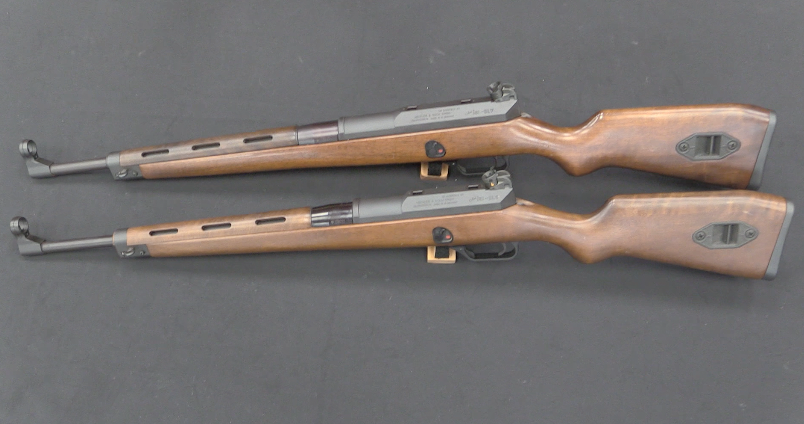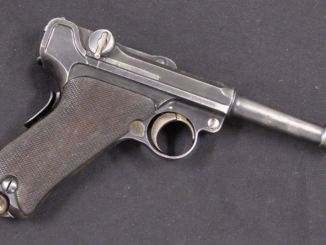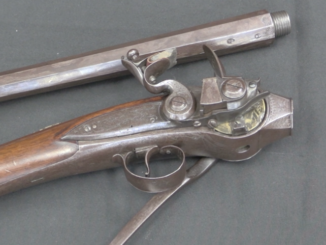Armament Research Services (ARES) is a specialist technical intelligence consultancy, offering expertise and analysis to a range of government and non-government entities in the arms and munitions field. For detailed photos of the guns in this video, don’t miss the ARES companion blog post!
The Korsac EM-1 (not to be confused with the Thorpe EM-1, which is a completely different rifle) was a bullpup light machine gun based on captured examples of the German FG-42 patatroop rifle. It was developed between 1945 and 1947 by a team led by Polish refugee designer named Korsac.
It was chambered for the 8mm Mauser cartridge, and used an 18 round magazine adapted from the ZB-26. The operating mechanism was closely copied form the FG-42, as were many elements of the rifle’s controls, including the capability for firing from an open bolt in fully automatic and from a closed bolt in semiautomatic. Unlike the FG-42, it used a short stroke tappet type gas piston, and had a detachable barrel. Ultimately only two examples were built, and only one of those (the one in this video) was completed to firing condition. It suffered from reliability problems in semiautomatic mode, and was quickly sidelined in favor of the other development projects ongoing by 1947. However, many lessons from its development would be put into the EM-2 rifle.




The trigger/sear arrangements seems like it might allow for a better (more crisp) trigger than on other bullpens since it eliminates the long flexible transfer bar/rod often seen on bullpups.
It seem to me too. Transfer of trigger pull is by solid machined piece and that is for sure a positive feature (as opposed to various links made out of bent wire). One good point for Korsac.
Again, good show and thanks.
When looking at this weapon, couple of thoughts pop up. The first, which was already partially answered is that when bolt is closed and firing pin is on sear, there is no force to hold bolt in locked position. Bolt may inadvertently partly open and cause a hazard to user.
The second thought, at semi-auto setting, what interrupts firing of next shot, e.i. disconnect. Maybe going back to FG42 would answer my question. My quick guess is that semi-auto sear is held intermittently and pops back after trigger is squeezed. This happens faster than time required for movement of action at its entire travel.
Finally, the interface of metal receiver with human flesh when in touch must be uncomfortable, but I understand this is prototype not showing all the features. Ultimately this teaches that to get a project materialized takes lots of effort without any guarantee of success. This had been demonstrated aplenty on FW already.
“this is prototype not showing all the features”
This is clearly shown, by caliber chosen – 7,9×57 Mauser. I wonder which cartridge they want to us in final version? – .303 British might be problematic due to its rimmed nature, but not impossible to use (cf. BREN machine gun), when .30-06 seems also likely candidate as weapons in this caliber were supplied to Great Britain during WWII.
Great Britian manufactured 7.9x57mm throughout WWII, for the BESA machine gun used in flexible mounts on AFVs. Dieudonné Saive’s Self-Loading Experimental Model 1, direct ancestor of the SAFN and grandsire to the FAL, was developed for 7.9x57mm- presumably because it was a rimless rifle round already in production in the UK.
In fact, although I can’t back it up, I suspect I’ve read somewhere that the British had considered 7.9x57mm as a replacement for .303 at one point, on the grounds of the rimless round’s greater suitability for autoloaders.
“used an 18 round magazine adapted from the ZB-26”
Wait, 18, why 18?
Probably just downloaded it and found that 18 was the sweet spot for reliable feeding after running into some problems using an unmodified one.
The Bren, the Chauchat, and the PPSh-41 suffered the same problem: trying to load the theoretical maximum capacity overloaded the magazine springs.
Most high-capacity magazines of the time had that problem. The Sten and Lanchester SMG magazines, rated at 32 rounds, worked best with only 28. The MP38/MP40 SMG magazines, also rated at 32, functioned best with only 30.
Even pistol magazines had problems. The P.08 magazine, officially an 8-round, worked better if you only put 7 rounds in it.
Incidentally, I found this out while browsing through W.h.B. Smith’s 1943 Basic Manual of Military Small Arms. Essentially the original edition of what later became Small Arms of the World, it has a lot of the photos, descriptions, etc. that showed up in later editions. Plus ones that were not seen again, like the complete operation and stripping procedures for the Lewis Gun.
It’s available for free in PDF right here;
http://photos.imageevent.com/badgerdog/generalstorage/piclinks/a_basic_manual_of_military_small_arms.pdf
Courtesy of Milsurps Knowledge Library.
cheers
eon
Many Lanchester magazines were hugely long 50-rd. affairs that would not even fit in the pattern 1937 webbing pouches…Doubtless these did not work too good fully stuffed… And loading ’em must have taxed whatever loading tool was on offer? The Bren gun was usually down-loaded a couple rounds, and had the rims to worry about too. I have it on reasonably good authority from Vietnam veterans that the M16A1 “jammin’ jenny” magazine was loaded with 18 rounds instead of the nominal 20. While requests were made as early as 1966-67 for parity with Kalashnikov magazines (which apparently work with 30 rounds), these didn’t begin to arrive until 1969 and 1970/71 by which time “Vietnamization” and handing things off to ARVN were underway.
I don’t know bout the Lanchester 50 round magazines, but the Swedish designed 50 round so called “coffin” magazine for the Suomi SMG would not work reliably with more than 45 rounds loaded. The recommended number was in fact 40 rounds in the Finnish Army; I don’t know about the Swedes. Cautious people would often load only 35 rounds, especially if the magazine (or rather the springs) were not new. Loading the thing to anything more than about 10 rounds required a loading tool.
SO even in semi auto mode, is that firing by a sear letting the whole bolt assemble getting driven forward by the recoil springs? I don’t see how else it could work. The firing pin is connected to the gas piston. .. Is there a different mechanism for firing in Sa than in full auto, or are you basically shooting by letting go of the bolt in semi auto the same as you would be in full auto only from a closed bolt (all but the last bit of distance..ie not the last bit of length of the bolt cut just after the helix straightens back out). That seems so strange but I don’t know how else it fires. I’ve never seen the trigger mechanism of an fg42 even on the web, but is it just like a machinegun’s This might explain why it’s not so reliable in SA?
My understanding of the FG-42 is that the chamber was cylindrical to allow the case to fire form to the chamber. This helped to maintain a gas seal because the gun opened at higher pressures in an attempt to cut weight. The choice of RH or LH bolt rotation could be related to this. When the bullet is in the bore, it begins spinning. The equal and opposite reaction to this is the gun rolling in the opposite direction. The bolt acts as an inertial weight and either locks tighter or begins unlocking. Do these two guns guns have the same twist direction and chambers? The Korsac piston looks slightly longer which means the gas block can be further from the chamber and unlocking pressure would be lower.
So that’s a milled receiver? looking at it on the video my first impression was that it is sheet metal. I would think that if it had gone into further development a stamped receiver would have been the way to go, since it would be much easier to install the threaded trunnion for the barrel and weld it into place. I’d imagine that the seam would lead to a weak spot that might not survive prolonged use and stress It sounds like all this needed was a bit of refinement and a stronger spring to be a really good fully operational design. pretty cool design though and with a little modification to the sear it would make an easy semi auto conversion…. Too bad there’s only one
Fascinating video. Had no idea that the Brits had applied the FG-42 operating system to a bullpup.
Couple of points–Ian didn’t mention the Lewis gun, which is where the Germans copied this operating system’s fundamentals from.
Second point? LOL… Compare this gun, the FG-42, and the M60. Note the bolts, most carefully, particularly where the cam track ends at the front end of the bolt: See how the FG-42, and this one-off copy both have drilled relief cuts, in order to eliminate peening? Now, go look at the M60, where those two drillings are not present. Ladies and Gentlemen, may I present to you the conclusive evidence that the idiots we had working US ordnance at the time of the M60 adoption were apparently dropped on their heads an awful lot when they were children? There it is, before you: Elimination of those two relief drillings created so much work and parts wear for armorers to deal with over the course of the weapons life that it’s not even funny. Lewis guns, in the variants I’ve seen, also had these relief cuts made. How is it that the M60 designers missed this, and why they were made?
You tell me. I think they were just idiots. The guys making the “product improved E6” variants of the M60 still haven’t figured this out, to my knowledge.
@Ian,
I’m afraid the post on Korsak rifle at ARES blog has not yet appeared.
Btw do you have idea whether the rifle was actually considered by the British Army as a prospective weapon to be adopted into service? If so did they thought of it as a light machine gun (a Bren replacement) or rather a selective fire rifle as a replacement of the Lee Enfield rifle?
Piotr
John Cantius Garand of Springfield Armory used a modified Lewis gun operating system on his top-feed/angled top magazine prototype for the “light rifle” trials that resulted in the adoption of the U.S. carbine, caliber .31 M1 with Winchester’s entry being adopted.
Question for the experts: It is my understanding, possibly gleaned from this very website, that in firearms of this type where the operating rod/pistol, firing pin, and cam lug within the bolt all move forward when the trigger is pulled and the sear is released, that the mass of parts tends to throw off accuracy. Is that the case? I mean the M60–in spite of its faults–was adopted as a sort of open-bolt GPMG. The Lewis gun originator is often deemed the superior LMG [“light” being relative in this instance] design of WWI…
Also, that this LMG prototype had issues with semi-auto firing may be a further indicator of potential problems? A double-ended firing pin seems natural for designs of this type, where a broken tip could be reversed into the rear as a sort of spring guide.
Thanks Ian! Very, very interesting!
One of these days someone will have to tie in the story of the BESA gun, of Czech design like the Bren, adapted by the Royal Armoured Corps as a tank machine gun in — 7.92 x 57 mm! If Korsac knew that .280 rimless was on the way, designing a prototype in Mauser rimless makes sense, especially if bits and pieces of Czech guns are lying around to be cannibalized. I have read that the British were actually considering replacing the Vickers with the BESA but couldn’t make BESA work with .303 rimmed. Might there have been for consideration a .280 BESA to replace the Vickers .303?
The .280/30 or 7x44mm replacement for the Vickers .303″ was the TADEN. This was, in essence, a belt-fed Bren gun that used the No.9 rifle/EM-2’s cartridge. The replacement for the Bren was to be the LMG version of the EM-2. The EM-2 was to replace both the No.4 Lee Enfield service rifle (1957!), and the 9mm SMG. But then the idea seemed to be that rear echelon troops would have the 9mm Madsen M/53 SMG. And then, of course, the self-loading rifle, aka L1A1/FAL in 7.62x51mm became the service rifle, the 9mm SMG was retained in the form of the Patchett/Sterling Mk.VI, the Bren gun was rechambered in 7.62x51mm, got a GPMG stable-mate with the FN-MAG, and the Vickers soldiered on until the late 1960s… When it was finally retired in favor of the FN-MAG.
Thus leaving poor stranded BESA serving in the RAC ’til ? With strange supply line as well… Many thanks for this interesting information.
I believe the designer’s name was Roman Korsak.
Designed around the same time were the Jesieranski EM-2 and the Metcalf EM-3.
I wonder what dimensions did the Korsak rifle actually have. ARES/Hoplite blog’s entry on the gun says its length was 43.5 inch (1104.9 mm), which is more a little than the FN FAL’s length, and barrel length was 20.5 inch (520.7 mm).
I dare think these are not correct figures. I’ve done an experiment, measuring (in pixels) the Korsak rifle in the drawing:
http://i338.photobucket.com/albums/n430/petrus_optimus/Korsak%20Rifle_zpsbuj8ttgh.jpg
If its over-all length is 1184 pixels and the barrel lenght (including flash hider) is 777 pixels, than the real thing could have had
EITHER
length of 43.5 in (1104.9 mm) and barrel length of 28.54 in (725 mm)
OR
length of 31.26 in (794 mm) and barrel length of 20.5 in (520 mm).
(Obviously all the figures are approximate).
Looking at the video I feel the latter figures are true, as the rifle doesn’t look as if it were as long as the FAL. My impression is its dimensions are closer to that of the L85.
Piotr